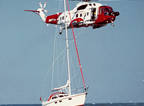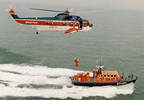..........Bristow
Base: Coastguard SAR, UK.
 As
can be seen from the map the Coastguard SAR 61
As
can be seen from the map the Coastguard SAR 61
bases are located at Stornoway, Sumburgh, Lee-on-
Solent and Portland. The first base to come on line was
Sumburgh in 1983 and was followed by Stornoway, 1987,
Lee-on Solent, 1988, and finally, Portland in 1995. All
the contracts have been successfully rebid after competitive tendering and are
normally awarded for a five year period.
Each base is equipped with a primary SAR machine being fitted out with 4 axis
coupled autopilots, forward looking infrared (FLIR) cameras, dual hoists,
VHF and UHF homers, electronic HSIs with RNAV and weather radar overlay
and numerous navigation systems ( NAV, ADF, RNAV, DME, GPS, DOPPLER ).
Then there are the dual radio altimeters, AVAD (ground
proximity warning),
mode C Transponder and comms systems including dual VHF and single HF,
UHF, FM. How do we fit it all in I hear you say? With great difficulty says
I,
speaking from experience!
Each base can also call on the services of a back-up aircraft when the need
arises although they are not equipped to such a degree.
 This
shot is of G-BIMU at Lee-on-Solent. The base
This
shot is of G-BIMU at Lee-on-Solent. The base
used to be shared with the military who have long since
departed. The building behind the 61 houses the line
office, crew room, stores, workshops etc etc.
Both helicopter and crew are required to remain at 15
minutes notice to
proceed between 0800 - 2100 and at 45 minutes overnight. Recently I was
carrying out a pre-mod survey on G-BIMU when it was called out and it
was out running in about 5 minutes!
 G-BDOC
hovering over the remains of "Piper Alpha".
G-BDOC
hovering over the remains of "Piper Alpha".
This Sumburgh based machine is ideally positioned to
cover the northern North Sea oilfields.
The Coastguard Helicopter's primary role is for
maritime search and rescue but can be tasked in an
additional role in support of the Police, Mountain Rescue or Fire Service or
to assist with patient transfer. The Stornoway machine is frequently required
to carry out long range missions into the Atlantic to the extent of their range
(245 nm) although this is not carried out without the assistance of an RAF
Nimrod as cover for the helicopter and casualty location prior to the heli-
copters arrival.
 Currently
based at Lee-on-Solent, G-BDIJ can often
Currently
based at Lee-on-Solent, G-BDIJ can often
be seen, during the summer months, acting like a
mother hen to the hundreds of yachts and other small
craft which crowd the Solent. The SAR operations
have a close link with the local community and each
base has endless amounts of press articles cut from local newspapers telling
the story of numerous incidents in which their helicopter was involved.
It used to be quite common for TV news crews to fly
on missions but recently
we have been fitting VCRs to the aircraft to enable rescue footage to be sold
on the world media market and hopefully help with funding.
 As part of the contract the SAR crews spend many
As part of the contract the SAR crews spend many
hours on training exercises and work closely with
the other emergency services. This photo shows
G-BCLC (currently a standby aircraft) on a typical
training sortie with the local lifeboat crew.
 A
lot of very grateful people have passed through
A
lot of very grateful people have passed through
this door. It is a brave man who hangs on a thin cable
over a stricken ship in the middle of a force 8 gale.
 This
shot shows a crewman at the FLIR station. He is
This
shot shows a crewman at the FLIR station. He is
controlling the FLIR camera with a small joystick and
monitoring the image on a TV monitor housed inside
the white box.
The configuration of the S61N lends itself to the search
and rescue role. The
long stable fuselage provides an excellent platform for winching whilst
the
large unobstructed cabin allows room for the carriage of rescue, safety and
survival equipment, and for the resuscitation and first aid treatment of
survivors.
Hover Stabilisation.
Keeping a helicopter in a steady state of hover over a survivor whilst he is
being winched to safety is difficult enough in perfect conditions due to the
aircraft's inherent instability. To attempt such a manoeuvre at night or in
bad visibility, with the lack of visual clues and peripheral references, is
virtually impossible. The Bristow SAR system enables a steady hover to be
maintained over a target by the fitment and use of the Louis Newmark LN450
Flight Path Control and Auto Hover equipment. A digital microprocessor
system translates information from a variety of aircraft sensors that control
the "autopilot". The pilots only have to monitor the flying controls
as the
autopilot makes all the control inputs and will only intervene in the unlikely
event of a system failure.
The system includes an innovative feature called the "Overfly" which
is
selected when a survivor is located. The helicopter flies over the survivor
at search height around a modified "racetrack" pattern and brings
the
aircraft into wind at a point from which an automatic "Transition Down"
takes place. During this phase, the helicopter's height and speed are
progressively reduced until the helicopter comes to an automatic hover
near to the survivor. All this happens without the need for the pilots to have
any external visual references and as long as the location of the survivor
can be determined, the rescue can be completed without the pilots seeing
outside the helicopter. Once the aircraft is hovering close to the survivor
the winch operator can make small inputs to the autopilot via his own
control panel located at the hoist station.